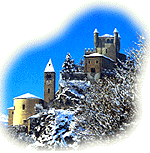|
The Central Valley crosses the entire length of the region, following the course of the Dora Baltea from Courmayeur to Pont-Saint-Martin. There are some small ski resorts on both sides, an interesting alternative to the more well-known areas.
Aosta Valley is about a hundred kilometres long and the sides of the Valley have very different climatic and environmental characteristics. The southern side, or "envers", facing north, is shady, wet and densely forested with conifers up to very high altitudes; the northern side, or "adret", however is sunny and dry. Along the Central Valley you can still see traces of a history-steeped past, from prehistoric and Roman remains to the medieval castles and towers strategically placed at the entrance to each of the lateral valleys. At the bottom of the valley of particular interest are the Road of the Gauls at Donnas, the fort and medieval village of Bard, the castles of Issogne, Verrès and Fénis, all open to visitors.
Above Saint-Vincent (575 m.) known world-wide for its "Casino de la Vallée", the biggest in Europe, there is the skiing area of Col de Joux (1640 m.). On a scenic balcony stretching between Ayas Valley and the Central Valley, the skier will find some short, intermediate level, downhill runs and an easy cross-country skiing track.
Among the hills above Chambave (486 m.) are the plateaux with the Semon ski lift (1369 m.), just right for beginners, and the cross-country skiing track at Verrayes - Champlong (1648 m.) which offers a superb view of the mountains of the Wildlife Park of Mont Avic.
Proceeding towards Aosta you reach the Valley of Saint-Barthélemy, between Valtournenche and Valpelline.
From Nus (530 m.) you reach Lignan (1633 m.), a small secluded ski resort at the foot of Mont Faroma and Becca di Luseney. Its wide natural spaces are ideal for the visitor who prefers tranquil holidays. The gentle slopes behind the village have some ski lift serving easy downhill runs, ideal for children and first-time skiers.
For the cross-country skier there is a magnificent track weaving through clearings and dense coniferous woods into the deep valley of Saint-Barthélemy. The peaks and slopes of the zone are classic venues for ski climbers.
Continuing along the Central Valley beyond Nus, you come to Aosta, with its important Roman and medieval monuments, the famous St Orso Fair (30-31 January), and the amenities of a modern but very liveable city. Then castles again: Sarre, Sarriod de La Tour and the castle of Saint-Pierre which houses the Natural History Museum. At Saint-Pierre you are within easy reach of the charming resort of Saint-Nicolas with its good hotel facilities and interesting cross-country skiing tracks - you can even ski by night.
Here, the "Centre d'Etudes Franco-Provençales Abbé Cerlogne" documents the ethnic history of the people of Aosta Valley. Following the main road leading to the Mont Blanc Tunnel, at Morgex you can go up towards Tête d'Arpy, where cross-country skiers can try two circuits, one 5 and the other 8 kilometres long, close to the characteristic village of Arpy. All the localities in the Central Valley, with their good tourist accomodation, make ideal starting points for those who instead of a one-stop holiday prefer a touring holiday discovering Aosta Valley.
 |




